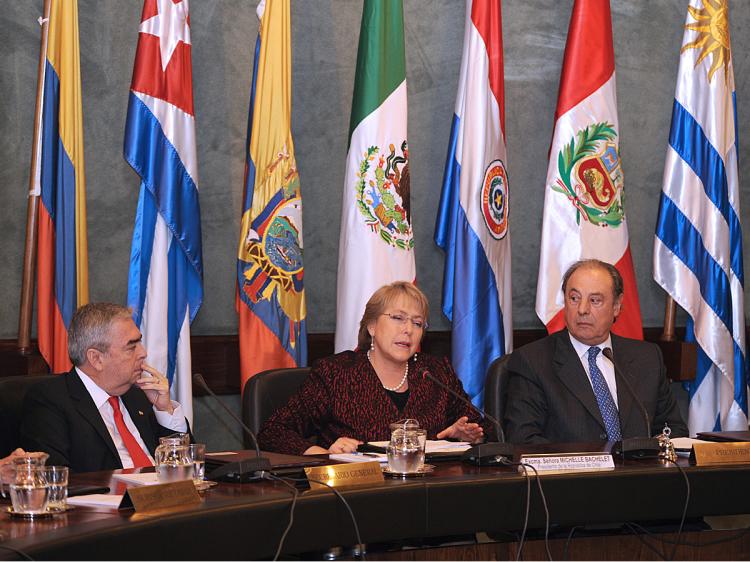Argentina, Bolivia, Brazil, Chile, Colombia, Mexico, Paraguay, Peru, and Uruguay are looking for Latin American cooperation, according to a recent Latin American Integration Association (ALADI) 10-country survey.
ALADI suggests that the devaluation of the U.S. dollar gave a boost to Latin American currencies, encouraging them to find new sales venues.
“In the case of Colombia, two key factors are the dynamics of international demand and foreign exchange rates,” said Javier Diaz Molin, president of the National Association of Foreign Trade in Colombia in a recent Knowledge @ Wharton (KW) report. “When it comes to exchange rates, things are not going well: The Colombian peso has been significantly revalued. However, demand is positive, and it is always good to have buyers in your own neighborhood.”
ALADI was formed in 1960 when its member countries hoped to reduce or eliminate tariffs and establish a free trade zone in South America. The members also signed a scientific and technological cooperation agreement.
During the first quarter of 2008, intraregional trade for the 10 Latin American countries amounted to $27 billion and increased by approximately $6 billion over last year. Member countries experienced a GDP growth rate of 5.2 percent, according to statistical information provided by ALADI in its Electronic Bulletin No. 8.
Intraregional exports also rose by 31.5 percent, with Paraguay leading the way with a 95 percent growth, followed by Ecuador with 85 percent, and Bolivia with 61 percent. Import growth was significantly lower for each of these countries. Ecuador’s trade surplus amounted to 59 percent, Paraguay at 40 percent, and Bolivia at 29 percent.
Pros and Cons
More than one-third of first quarter 2008’s growth in trade arose from trade agreements, which called for elimination of tariffs and trade barriers, harmonizing of markets, and other trade cost reductions.
The most significant agreements are MERCOSUR (Southern Cone Common Market) treatment between Argentina, Brazil, Paraguay, and Uruguay; the Andean Pact (Andean Common Market) between Bolivia, Colombia, Ecuador, Peru, and Venezuela; CACM (Central American Common Market) between Costa Rica, El Salvador, Guatemala, Honduras, and Nicaragua; and the ALADI Group with 12 member countries, which also include Peru and Venezuela besides the aforementioned countries.
Intraregional trade is a very small percentage of the regions trade, despite bilateral and multilateral trade agreements, according to the KW report.
Colombia holds only around 12 percent of Venezuela’s trade, and only 0.2 percent of Mexico’s trade.
“There is a shortage of trade intelligence, confidence, and knowledge of neighboring markets,” suggests Jorge Alberto Velasquez, professor of international trade at the Bolivarian Pontifical University of Medellin in Colombia.
One reason is that Latin American press tends to promote trade agreements with the United States and Europe instead of concentrating on intraregional trade agreements and benefits.
A major drawback for intraregional growth is political tensions among Latin American countries, said Francisco Giraldo, professor at the Externado University in Colombia, in the KW report.
Giraldo explains that Latin American countries’ governments and heads of state may get along well. But, the minute the relationship sours, the trade relationships don’t walk but run out the door.
“Politics has a great deal of influence on trade in Latin America, unlike the situation in Europe. There, given the high level of integration, no matter who governs those countries the economic dynamics remain the same,” Giraldo said in the KW report. “This problem reflects the immaturity of many Latin American countries.”
Business Conquistadors
With growing clout, many Latin American companies are moving from the conventional wisdom of selling a product to dreaming of growing through intraregional mergers and acquisitions (M&A).
“Brazil and Mexico are two of the biggest players in that regard [M&A],” claims the KW report.
KW identified 10 Latin American companies that are taking the M&A road, including Petrobras Brasileira, S.A., the Brazilian oil giant that has bought and invested in most Latin American markets. The Brazilian cement company Camargo Correa took over Loma Negra Compania S.A., an Argentina cement company for $1.03 billion ($750 million in cash and assuming $250 million of debt) in 2005.
“If the 1990s were characterized by the inflow of European and U.S. investment into Latin America, the last five years will be remembered for the movement of capital among Latin American countries,” KW said. “Imports, exports and mergers that were unthinkable a decade ago have begun to play a key role in the [Latin American] business environment.”




